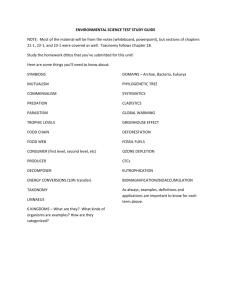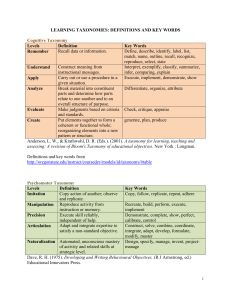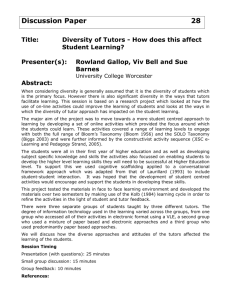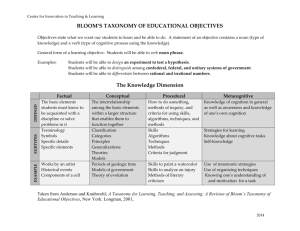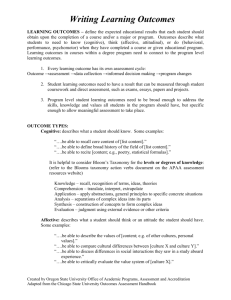Physics Assessment and the Development of a Taxonomy
advertisement
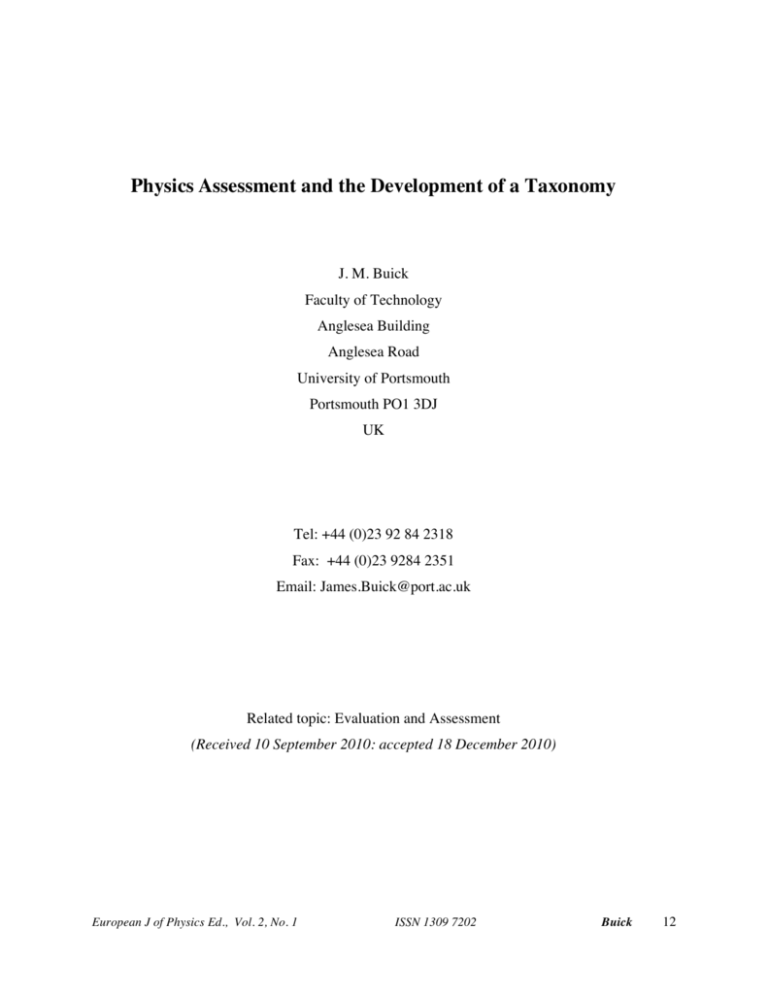
Physics Assessment and the Development of a Taxonomy J. M. Buick Faculty of Technology Anglesea Building Anglesea Road University of Portsmouth Portsmouth PO1 3DJ UK Tel: +44 (0)23 92 84 2318 Fax: +44 (0)23 9284 2351 Email: James.Buick@port.ac.uk Related topic: Evaluation and Assessment (Received 10 September 2010: accepted 18 December 2010) European J of Physics Ed., Vol. 2, No. 1 ISSN 1309 7202 Buick 12 Abstract Aspects of assessment in physics are considered with the aim of designing assessments that will encourage a deep approach to student learning and will ultimately lead to higher levels of achievement. A range of physics questions are considered and categorized by the level of knowledge and understanding which is require for a successful answer. Taxonomy is then proposed to aid classification. Keywords: Physics; Assessment; Taxonomy Introduction Assessment is an essential component of teaching in any institute of higher education. Here assessment in physics is considered in the context of taxonomy. In general taxonomy is a classification system. In education, taxonomies have focused primarily on evaluation and objectives. Bloom's Taxonomy (Bloom et al. 1956) was the first model developed to provide a systematic classification of cognitive operations for use in education. It provided six hierarchical levels of cogitative complexity in which each level must be mastered before progressing to the next. Bloom’s Taxonomy, including modifications and variations, which have been developed since its inception, is now widely used in course development in higher education to ensure that that both teaching and assessment strike the right balance between low level skills such as memorizing, and higher level skills such as analyzing and applying. An alternative approach is provided by Biggs SOLO (Structure of Observed Learning Outcomes) taxonomy (Biggs and Collis 1982). This identified that learning initially improves as the level of detail in a student’s response increases, and later as the detail becomes integrated into a more structured answer. This paper investigates assessment in physics. A spectrum of assessment methods are considered with the main emphasis placed on examination. This is generally the principle method for determining student grades when certification is required. Historically examination has been used as the main mechanism for assessment and this is likely to remain European J of Physics Ed., Vol. 2, No. 1 ISSN 1309 7202 Buick 13 the case since it ensures equity of treatment for students and provides a level of quality assurance and accountability. A number of examples of potential exam questions are considered along with the level of knowledge, skill and understanding that is required in answering them. From this taxonomy for physics is produced to aid classification. Unit Composition Any physics unit must satisfy a number of criteria. There is a body of knowledge that students must take from the unit. This can be divided into two main categories: information which the students require as a prerequisite for future units; and knowledge which would be expected of a physics graduate wishing to continue their studies at a higher level, undertake research in physics or enter employment. It is, however, important that students take more from the unit than simply a bundle of knowledge. The students must also learn skills. This includes skills that they can apply in other units to different subject matter, as well as skills that they can transfer to other arenas outwit the university. Students undertaking physics major must acquire the skills necessary to undertake a career in physics. In addition, they must also learn skills that are required by most employers. These include practical components such as computing as well as other skills such as time-management, ability to work as a team, presentation skills and information literacy. Thus an educator must ensure that a portion of a unit must follow the traditional discipline-based approach (Toohey 1999: 49) while also incorporate aspects of the personal relevance approach (Toohey 1999: 59). Assessment Design From the point of view of the students, certainly for surface learners, the curriculum of the units is defined by the assessment (Ramsden 1992: 187). It is therefore essential that the assessment tasks cover the whole curriculum, both in terms of knowledge and skill bases. A non-exhaustive list of assessment methods commonly applied to a physics unit is included below, along with a discussion of the merits of each approach. Assessments can have two objectives: summative or formative (Biggs 2003: 141). Summative assessment provides European J of Physics Ed., Vol. 2, No. 1 ISSN 1309 7202 Buick 14 results that are used to grade students while formative assessment provides students with feedback during the learning process. Assessment can take many forms; written, on-line, oral presentation; however, they can generally be divided into three types: assignments; laboratory/project reports; and tests/exams. Assignments: A number of assignments throughout a unit provide a useful method for ensuring that students are keeping up and identifying any problems. They also provide essential feedback to the student indicating the level of knowledge or ability that is expected from them and also the extent to which they are achieving this. Assignments should be mainly for formative purposes. Since they provide important information for both the student and the lecturer regarding the progress of the students, these should be a compulsory part of the assessment, possibly with some weight in the overall summative assessment. This gives the students an incentive to put effort into the assessment ensuring that the student gains maximum benefit and that the formative aspects of the assignment is meaningful. The ability to build up marks prior to a final exam is also beneficial to the student and can make any final exam less threatening. When designing and marking assessment it is important to ensure that assignment questions cover as much of the material as possible and are of a similar standard as the test/exam questions. This ensures that students are given a clear indication that the whole of the curriculum is important. It also gives the students an opportunity to judge how they are performing in the unit and offers a source of feedback in areas where they are having difficulties. Laboratory/Project Report: Practical work is an important aspect of physics and so its assessment should reflect this importance. Assessing practical work generally assesses skills rather than knowledge. Some knowledge of the subject matter is required to undertake the practical work, but significantly less than any other part of the unit assessment. The skills assessed are also generally different to those assessed in a test or exam. The main skills assessed are communication, teamwork and practical ability. Assessing laboratory work is commonly done through a formal report. To produce a high quality report a student must work well during the laboratory session and exhibit skills such as teamwork. The importance of these skills must be recognised by giving them a significant weighting. Aspects of the assessment of laboratory work are also formative. Ensuring that practical assessment is done European J of Physics Ed., Vol. 2, No. 1 ISSN 1309 7202 Buick 15 in small chunks, for example, every week, allows students to learn from the assessment and improve their skills in the same manner as discussed for assignments. This means that the assessment can be both formative and summative. Exams and tests: These methods of assessment are primarily summative. They are used primarily to measure the knowledge and acquired skills of the student. Assessment through tests and exams will be considered in the remainder of this paper. Reflections on Assessment through Tests and Exams in Physics Having determined that the test and exam cover both the material in the course description and the learning objectives, it is important to investigate the level of knowledge and understanding, which a student requires to answer the exam or test questions. Two frameworks have traditionally been used for evaluating the different level of questions and the corresponding answers in a range of educational settings. These are provided by the SOLO Taxonomy of Biggs and Collis (1982), and by Blooms Taxonomy (Bloom et al. 1956). Before considering assessment in test and exams in physics the two taxonomies will briefly be reviewed. Biggs SOLO Taxonomy Five levels are identified: Prestructural level Students acquire pieces of unconnected information No organization Unistructural level Students make simple and obvious connections The significance of the connections is not demonstrated Multistructural level Students make a number of connections Significance of relationship between connections not demonstrated Relational level Students demonstrate relationship between connections European J of Physics Ed., Vol. 2, No. 1 ISSN 1309 7202 Buick 16 Students demonstrate relationship between connections and the whole Extended abstract level Students make connections beyond the immediate subject area Students generalise and transfer principles from the specific to the abstract Bloom’s Taxonomy Six levels are identified: Knowledge Recall of data Comprehension Understanding the meaning State a problem in one’s own words Application Use a concept in a new situation Applies what was learned in the classroom into novel situations in the workplace Analysis Separates material or concepts into component parts to understand structure Distinguished between facts and inferences Synthesis Builds a structure or pattern from diverse elements Put parts together to form a whole, with emphasis on creating new meaning or structure Evaluation Make judgements about values, ideas or materials. It is important to consider that the term ‘application’ in Bloom’s Taxonomy is used in a different sense to how it may be used in a syllabus or unit description. In the latter it may be used, for example, as ‘application of Maxwell’s equations’ or ‘application of Newton’s laws’. In terms of an exam question this could involve a problem similar to, or even identical to, a problem that the student has already seen, for example in an assignment question or as a lecture example. The implication in Bloom’s Taxonomy is that the situation or problem is ‘new’ is not present in this definition. It is also important to notice that the word ‘analysis’ is often used to describe mathematical manipulation. European J of Physics Ed., Vol. 2, No. 1 ISSN 1309 7202 Buick 17 Both Taxonomies apply to cases where the answer to a question can have a range of answers that illustrate the different levels of the student’s thinking. The following example is based on material from Biggs and Collins (1982). Two answers to the question ‘Why is the side of a mountain that faces the coast usually wetter than the side facing the interior’ are: “Because it rains more on the coastal side.” Because the prevailing winds are from the sea, which is why you call them sea breezes. They pick up moisture from the sea and as they meet the mountain they’re forced up and get colder because it’s colder the higher you get from the sea level. This makes the moisture condense which forms rain on the side going up. By the time the winds cross the mountain they are dry. Answer 2 clearly shows a deeper understanding of the process, while answer 1 simply states a fact. Both taxonomies have been applied to a wide range of topics; however, there are some limitations. In the field of computer science education Johnson and Fuller (2006) suggested modifying Bloom’s taxonomy by adding an additional top level entitled ‘Higher Application’ to account for “the application informed by a critical approach to the subject, but where the criticism is not, as such, the focus of the work”. Limitations have also been observed in the field of mathematics by Smith et al. (1996) who proposed a modification to Bloom’s taxonomy for structuring assessment tasks in mathematics. Smith’s MATH (Mathematical Assessment Task Hierarchy) taxonomy (Smith et al. 1996, Wood et al. 2002) consists of three groups A, B and C as detailed below: Group A Factual knowledge Comprehension Routine use of procedures Group B Information transfer Application in new situations Group C Justifying and interpreting European J of Physics Ed., Vol. 2, No. 1 ISSN 1309 7202 Buick 18 Implications, conjecture and comparisons Evaluation. Like mathematics, the application of both Bloom’s and Biggs’ taxonomies have limitations when applied to physics assessments, particularly above the elementary level. In a typical physics unit, for example, electromagnetism, there is no scope for ‘evaluation’ or ‘extended abstract level’ arguments as defined in the taxonomies. This level of reasoning may be applicable in areas of physics that are current areas of research such as the Big Bang Theory or the Grand Unified Theory. Advanced units in these, or similar topics, may include the latest theories and possibly evidence that contradicts established theories. These are topics of current research. In an exam question a student might describe such evidence, for example an experiment demonstrating CP violation, and discuss its consequences. Such an answer could demonstrate ‘comprehension’ and ‘multiscructural’, or even ‘relational’ thinking. This answer would consist of arguments initiated by others, and not by the student answering the exam question, and so in terms or the taxonomies could not be classified as ‘analysis’ or ‘synthesis’. It could not be expected that an exam answer would exhibit ‘evaluation’ or ‘extended abstract level’. Further, in a unit such as electromagnetic theory, the material covered is well established and there are no areas of speculation. It is also not practical to question the use of concepts such as electric fields. Often a question can only be answered at a single level. For example, consider a question asking for the force on a particle of charge q, moving with velocity v in a magnetic field B. The correct answer is that F = qv!B. A student could state this and then continue “Now if we observe this from a reference frame in which the charge is at rest the magnetic force will be zero. Thus we can conclude that the apparent magnetic force is actually an electrostatic force which can be understood due to a Lorenz contraction”. This level of insight was not asked for in the question and so no marks can be given for it. In a unit where the ideas expressed by the student had not been covered, this answer might appear to be at the extended abstract level in Biggs’ taxonomy or synthesis/ evaluation in Bloom’s Taxonomy. It is, however, unlikely that this answer represents a flash of inspiration on the part of the student during the exam. It is more likely that the answer represents information, European J of Physics Ed., Vol. 2, No. 1 ISSN 1309 7202 Buick 19 which the student has read and is repeating (possibly with no understanding of its meaning). In either case no marks can be awarded for this insight. The example, however, illustrates the limitation of applying either Bloom’s or Biggs’ taxonomy. The project report is one area of physics where Bloom’s or Biggs’ taxonomies can be truly applied. Here the students have a chance to display a high degree of reasoning and judgement concerning the interpretation of their results. For example, the student may criticise the procedure and suggest improvements; compare with other techniques/ methods; and identify other fields where such methods can be applied. This is typically the only opportunity a student will have to demonstrate ‘extended abstract’ or ‘evaluation’ within the evaluation process. Although mathematics and physics have a number of similarities, the differences between them mean that the application of Smith’s MATH taxonomy to a physics unit also encounters limitations. In the following section, different types of physics questions will be considered with a view to determining a taxonomy suitable for structuring assessment in physics. Taxonomy for Physics The concept considered in this section can be applied generally to most topic areas in physics; however, the examples considered will be taken from electromagnetic theory. In physics exams and tests it may be possible to ask question similar to the one above giving students the opportunity to answer according to their level of knowledge, understanding and insight. For example, consider the following question: A1: Describe the three major classes of magnetic materials, giving details of their differences and the physics behind these differences. This question offers students a chance to display their knowledge and/or understanding at different levels. Students can list facts they have learnt about magnetic European J of Physics Ed., Vol. 2, No. 1 ISSN 1309 7202 Buick 20 materials - factual knowledge. There is also scope to demonstrate comprehension in the second part of the question explaining the physics behind the differences. While it is possible in some instances to use questions such as the example above, generally it is only possible to answer a question on a single level. Consider the following questions: B1: State the expression for the electric field E at position r due to a point charge q at position r". B2: Sate Gauss’s Law B3: State the Lorentz force equation, describing each parameter and stating any requirements with regards the particle’s motion. B4: State Ampere’s circuit law. Each of these questions requires a statement of facts and the answers would be classified as factual knowledge. To enable students to demonstrate a higher level of understanding it is necessary to extend the scope of the question with a second part which either leads on from the initial statement of facts (B1-B4) or can be the starting point for the question. Consider the following examples that could be set as a second part to questions (B1-B4): C1: Consider a region containing two different dielectrics characterised by e1 and e2. By considering the normal and tangential components of E at the interface and applying Maxwell’s equations in integral form, determine the boundary conditions at the interface. C1": A total charge Q is spread evenly over the surface of a disk of radius a defined by x 2 + y 2 ! a 2 , z = 0. Find the electric field on the axis of symmetry (z = 0). Hence, or otherwise, show that the potential on the axis is given by $ axis ( z ) = Q 2"# 0 [(z 2 + a2 ) 1/ 2 ] !z, where f(#) = 0. C2: a) Explain how Gauss’s Law leads to the relationship ! D " dS = ! # dv . s v v b) Consider a sphere with radius a and uniform charge density rv. Determine D everywhere. European J of Physics Ed., Vol. 2, No. 1 ISSN 1309 7202 Buick 21 C3: A charged particle moves with a uniform velocity 4ax m/s in a region where E = 20ay V/m and B = B0az Wb/m2. Determine B0 such that the velocity of the particle remains constant (Sadiku 2001: 313). C4: A hollow conducting cylinder has inner radius a and outer radius b and carries current I along the positive z-direction. Derive expressions for H everywhere. Questions C1 and C2 a) can be classified as bookwork. The answer to these questions can be found in any standard textbook and will (presumably) have been covered in the lectures. As such a student could memorise the answer and reproduce it without any understanding. In this case the answer would not show any greater level of knowledge or understanding than the answers to questions B1-B4. In practice, unless a student memorises every page of the textbook and/or the lecture notes, simply reproducing the proof from memory is not possible. Despite not being able to recall the answer verbatim, a student will have some memory of looking at or working through the appropriate section of the textbook. Guided by this memory or by the approach suggested in the question (By considering the normal and tangential components of E at the interface and applying Maxwell’s equations in integral form), which may be omitted to change slightly the level of difficulty, the student must also exhibit a level of knowledge and understanding to produce the required answer. Thus a bookwork question generally requires more than simply reproducing factual knowledge, it also requires comprehension of the material and the ability to reproduce some standard work. Questions C1", C2b), C3 and C4 require the use of the facts that were asked for in questions B1-B4 respectively. This would normally be termed an application of the electrostatic force equation, Gauss’s Law, Lorentz force equation and Ampere’s circuit law respectively. Crucially, it should be noted that each question may or may not contain the novelty required in Bloom’s taxonomy. The ability demonstrated by a student correctly answering one of these questions cannot be determined solely by examining the questions. Undoubtedly methods for using these laws to determine physical properties will have been presented to the students previously, either through examples in the lecture/ textbook or through assignments questions. The questions must be subdivided into three categories: European J of Physics Ed., Vol. 2, No. 1 ISSN 1309 7202 Buick 22 A question that is identical or virtually identical to a question that the student has • already been exposed to or has already solved. This can be classified as application previously solved. A question that is broadly similar to a question already encountered, classified as • application - routine procedure. A question that is significantly different (in terms of the application of the law or the • method of mathematical solution) that it can be classified as application - novel. If two students give the same answer to a question they should both be awarded the same mark. If the students have different background the level of understanding exhibited by the students to obtain the same number of marks is different. Within any single class, however, the background of the students (at least with respect to the subject taught in the unit) should be similar. All students will have attended the same lectures, been directed towards the same textbook, and attempted and seen the solutions to the same assignment questions. Backgrounds will vary slightly where students have accessed alternative resources, for example, alternative book in the library. In this case a question that is ‘application - novel’ for one student may be classified as ‘application – routine procedure’ for another. In such a case the student with a larger pool of background knowledge is benefiting from this extra reading and understanding of the subject. A further category requires a student to take their knowledge and understanding of one area and relate it to another. For example consider D1 and D2 below that could follow questions C1" and C2. D1: Given the azimuthal symmetry of the problem, the potential must take the form $ * An ' + Bn r n %Pn (cos ! ) for a << r, where Pn is the Legendre polynomial. Determine n +1 & n =0 ) r " = #( the coefficients An and Bn. D2: For r > a describe how the solution relates to that for a point charge. D2 requires the expression for D that has previously been calculated in terms of the charge density to be compared with the expression for a point charge Q that must be known. This involves determining a relationship between the total charge and the charge density. It European J of Physics Ed., Vol. 2, No. 1 ISSN 1309 7202 Buick 23 requires relating the answer given in the previous part of the question to knowledge obtained elsewhere in the unit and determining the consequence of the comparison. This can be categorised as ‘relation – within topic’. (Provided this comparison had not been considered previously in lectures or an assignment in which case the question would be categorised as ‘application – previously solved’.) D1 requires an understanding of the solution of the Laplace equation in spherical coordinates. Although the form of the general solution is given, it would be difficult to answer the question without some understanding. This could relate to a different part of the unit, or possible a different unit on another topic, for example, mathematical methods. Knowledge and understanding of Legendre polynomials and the Binomial expansion and double factorials are also required. This is something that would most likely have been covered in a different unit. Thus a full answer required the student to bring together knowledge and understanding from other aspects of their physics course and also to determine a method to relate the two forms for the potential. This type of question can be categorised as ‘relation – outwith topic’. Given the limited time constraints of a test or exam it may be desirable to include a number of hints that will decrease the difficulty of the question without changing the level of categorisation of the question. This could include all or some of the following: Expanding your solution for f using a Binomial expansion, noting that " (!) = 0 , and comparing the solutions on the axis (r = z), show that Bn = 0 and $0, for n odd ! An = # (- 1)n / 2 (n + 1)!!a n ! (n + 1)(n / 2)!! , for n even. " It has been suggested that by altering the form in which a question is put, it is possible to change the level of understanding that a student displays in an answer (Pollard 1993). This work refers to first-year level physics and deals with the problem of students simply remembering formulae and inserting values to obtain a correct answer without understanding the underlying physics. Both questions C2 and C4 require more than simply putting numbers in an equation. The students need to understand the concept of a Gaussian surface or Amperian path, the symmetry of the problem and the appropriate integral to European J of Physics Ed., Vol. 2, No. 1 ISSN 1309 7202 Buick 24 perform. Pollard (1993) suggests re-writing a question to explicitly ask about the Gaussian surface. This prevents students from answering the question without understanding the concept. In, for example, C2 it is necessary for the students to use two different Gaussian surfaces. Thus the student needs to understand and use the concept to correctly and fully answer the question. Hence a student must display a higher level of thinking/ understanding to answer this question, without the need for Gaussian surfaces to be mentioned in the question. Further, by not mentioning Gaussian surfaces in the question it is necessary for students to be aware of the approach, which is required to proceed with the solution. Conclusion A progression has been highlighted in the type of exam questions that provide the opportunity for students to express higher levels of knowledge and understanding. These correspond to a) factual knowledge; b) comprehension; c) book work; d) application – previously solved; e) application – routine procedure; f) relation – within topic; and g) relation – outwith topic. It is important to implement procedures that encourage deep learning rather than surface learning. Toohey (1999: 13) indicates that surface learning is encouraged by assessment strategies that reward low level outcomes. Thus assessment tasks must require the students to produce high-level outcomes. It is hoped that the taxonomy detailed here will be an aid to designing assessment tasks in physics and therefore help encourage deep learning for students. Other aspects, which encourage a deep approach to learning, include (Biggs 1989): an appropriate motivational context; a higher degree of learner activity, interaction between peers and teachers; and a well-structured knowledge base. It is important to also consider these features within a unit. European J of Physics Ed., Vol. 2, No. 1 ISSN 1309 7202 Buick 25 Acknowledgements The author would like to thank Robyn Smyth and the members of PDLD490-04 for advice and useful discussions. The author would also like to thank Peter Osborne for bringing questions C1 and D1 to his attention. References Biggs, J.B. and Collis, K.F. (1982). Evaluating the quality of learning- the SOLO Taxonomy. New York: Academic Press. Biggs, J.B. (1989). Approaches to the enhancement of tertiary teaching, Higher Education Research and Development 8:7-25. Biggs, J. (2003). Teaching for Quality Learning at University. The Society for Research into Higher Education/ Open University Press, Buckingham. Bloom, B. S., Englehart, M. D., Furst, E. J., Hill, W. H., and Krathwohl, D. (1956). Taxonomy of educational objectives: The classification of educational goals. Handbook I: Cognitive domain. New York: Longmans, Green. Johnson, C. G. and Fuller, U. (2006). Is Bloom's taxonomy appropriate for computer science? In Baltic Sea ’06 Proceedings of the 6th Baltic Sea Conference on Computing Education Research (Koli Calling), pp120-122. Available online at http://citeseerx.ist.psu.edu/viewdoc/download?doi=10.1.1.100.3548&rep=rep1&type=pdf#pa ge=130 (accessed December 2010). Pollard, J. (1993). Developing physics understanding through guided study. In Bain, J., Lietzow, E. and Ross, B. (Eds.) Promoting teaching in higher education, reports from the National Teaching Workshop, Goprint, Brisbane, pp. 355-370. European J of Physics Ed., Vol. 2, No. 1 ISSN 1309 7202 Buick 26 Ramsden, P. (1992). Learning to teach in higher education, London, Routledge. Sadiku, M. N. O. (2001). Elements of Electromagnetics, 3rd edition, New York, Oxford University Press. Smith, G., Wood, L., Coupland, M., Stephenson, B., Crawford, K. and Ball, G. (1996). Constructing mathematical examinations to access a range of knowledge and skills, International Journal of Mathematical Education in Science and Technology 27: 65-77. Toohey, S. (1999). Designing courses for higher education. The Society for Research into Higher Education/ Open University Press, Buckingham. Wood, L.N., Smith, G.H., Petocz, P. and Reid, A (2002). Correlation between student performance in linear algebra and categories of a taxonomy. In 2nd International Conference on the Teaching of Mathematics (at the undergraduate level). Crete, Greece, John Wiley & Sons. Available online at http://www.math.uoc.gr/~ictm2/Proceedings/pap338.pdf (accessed December 2010). European J of Physics Ed., Vol. 2, No. 1 ISSN 1309 7202 Buick 27




